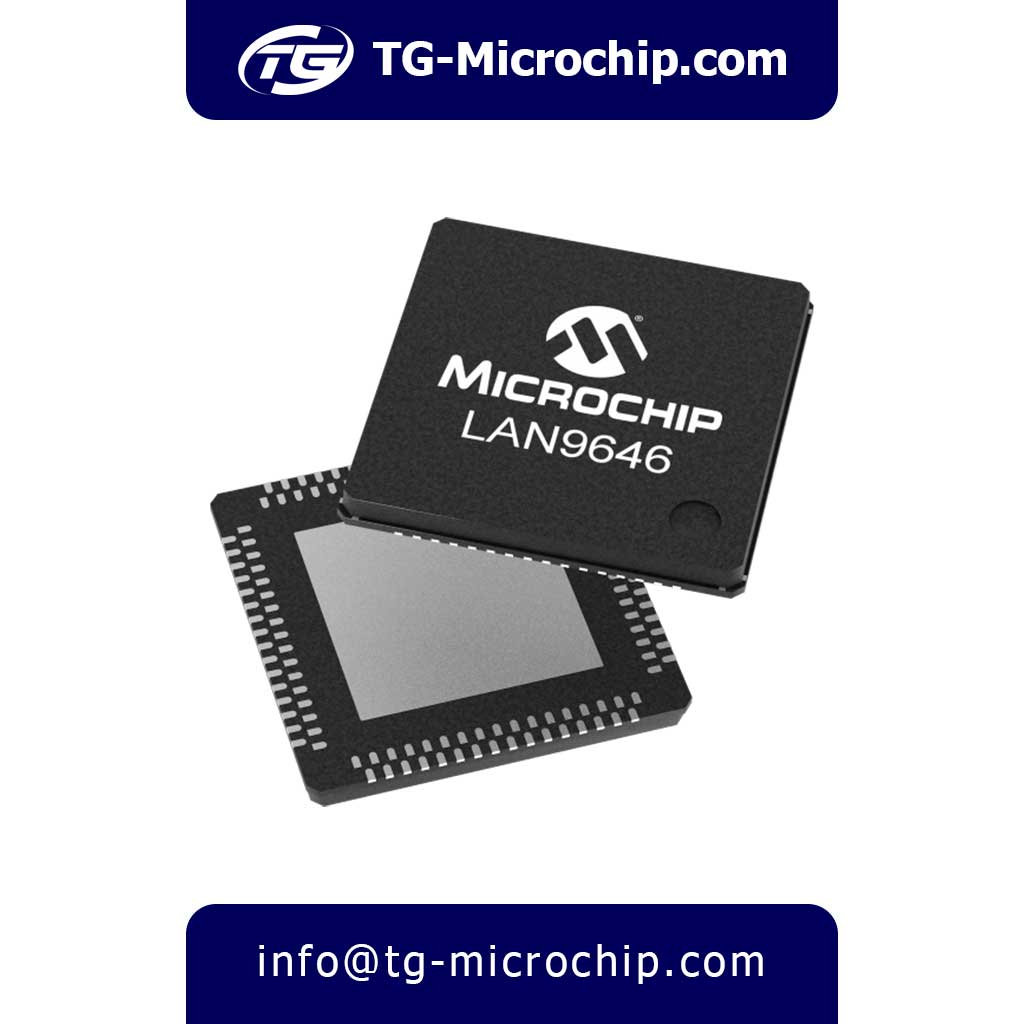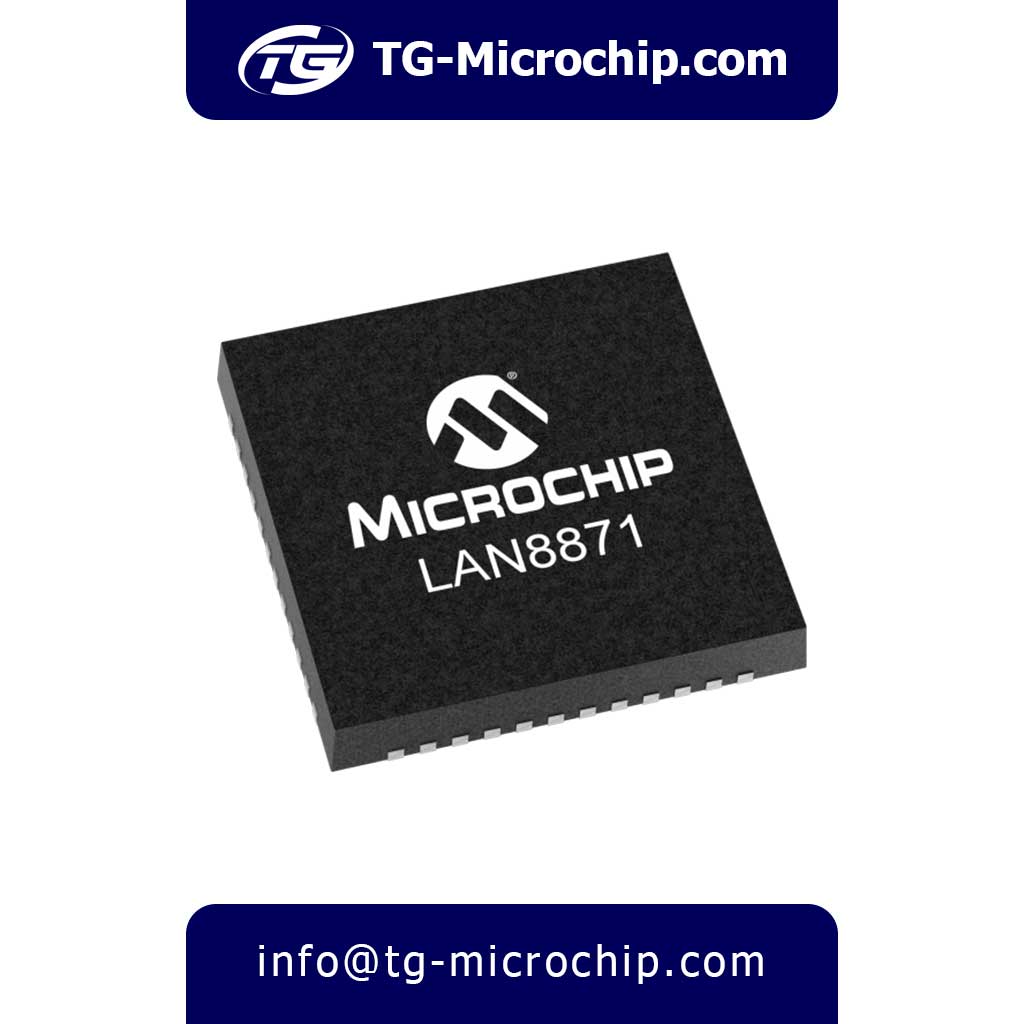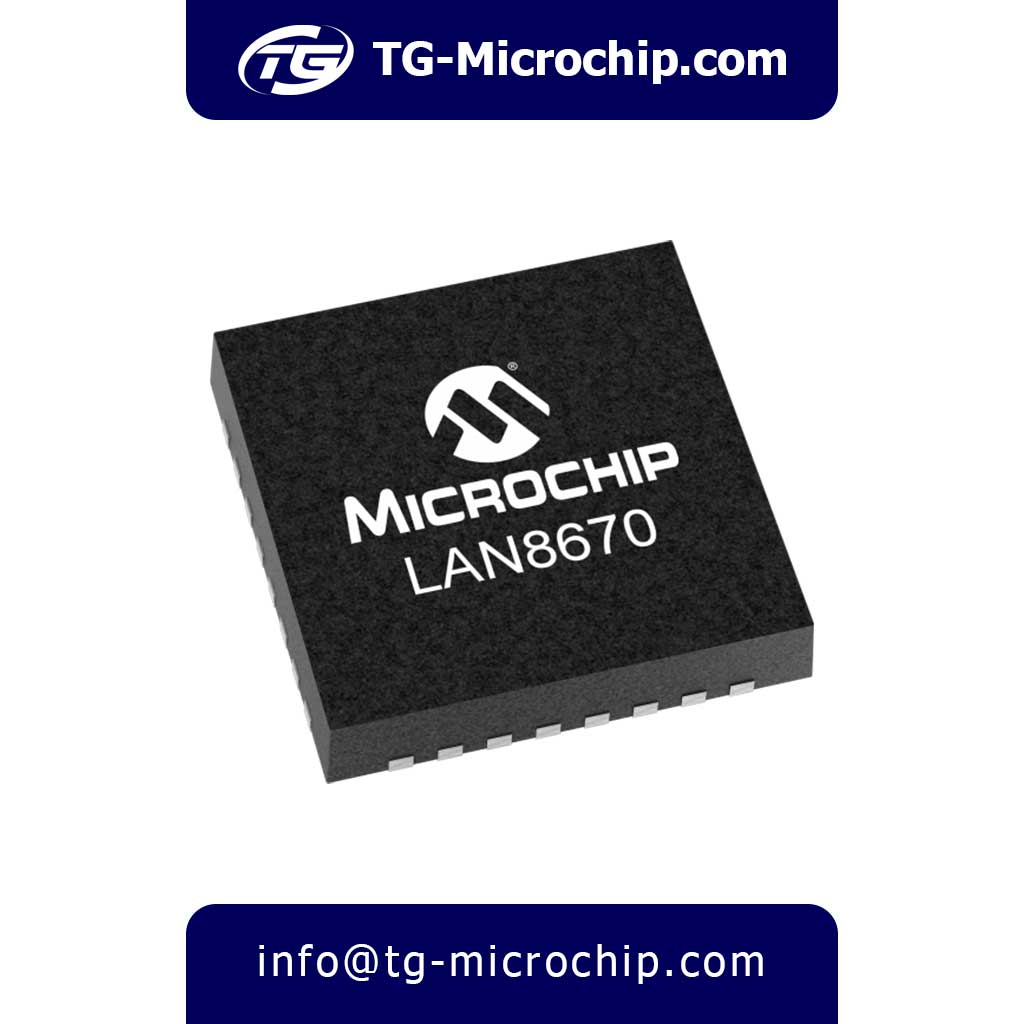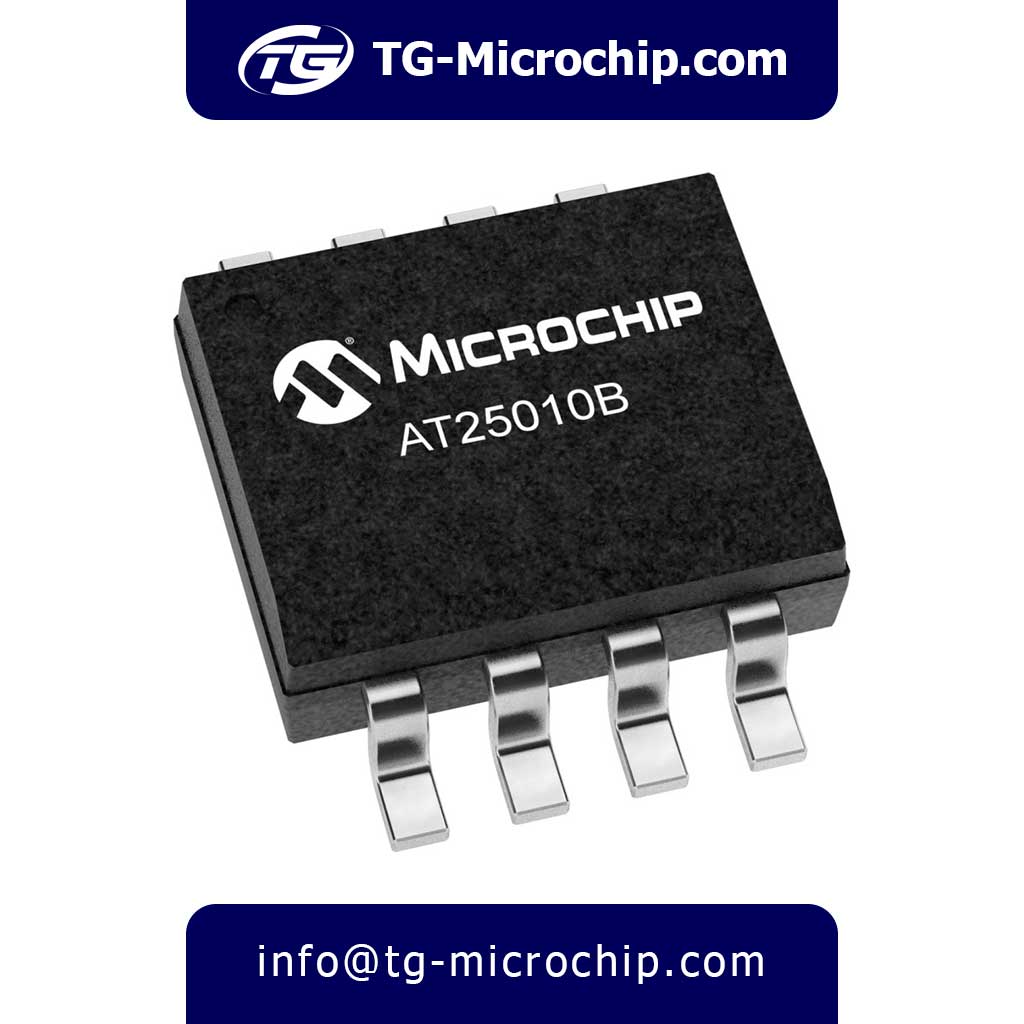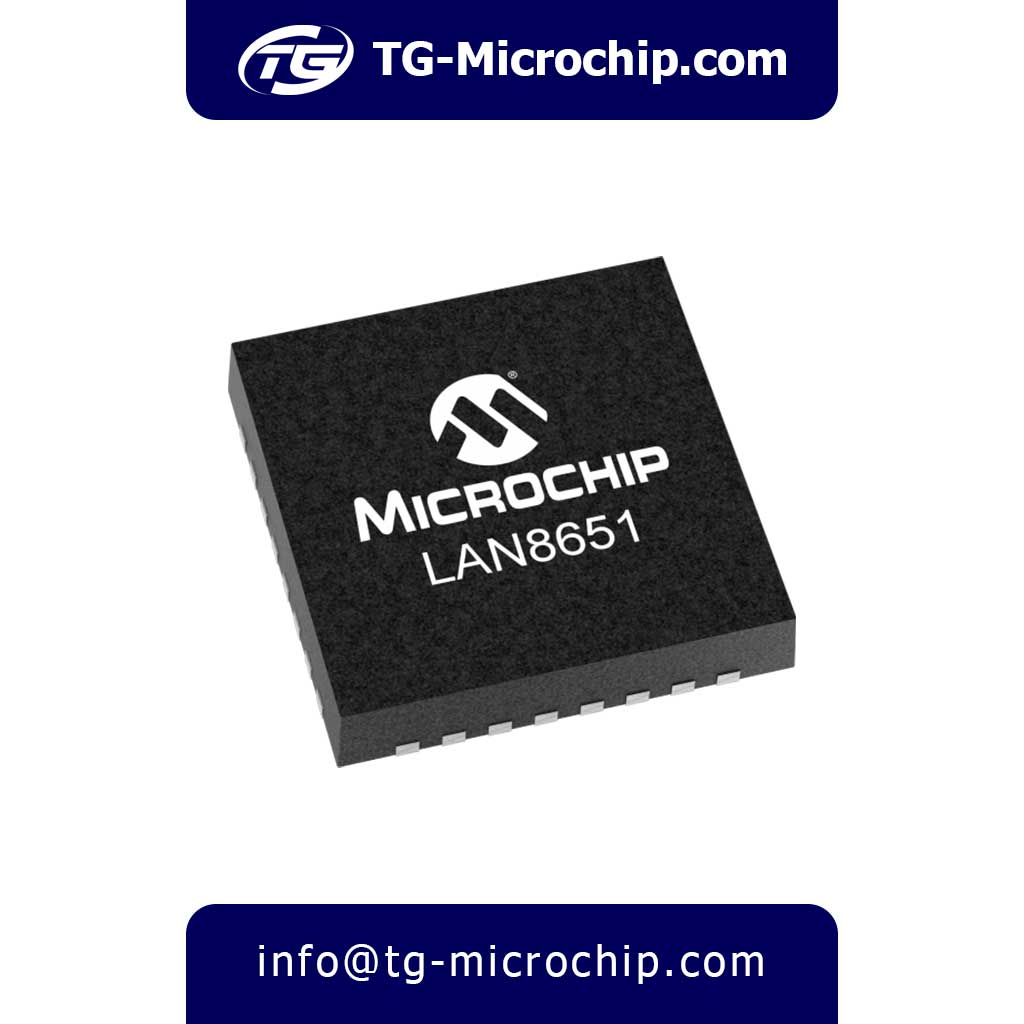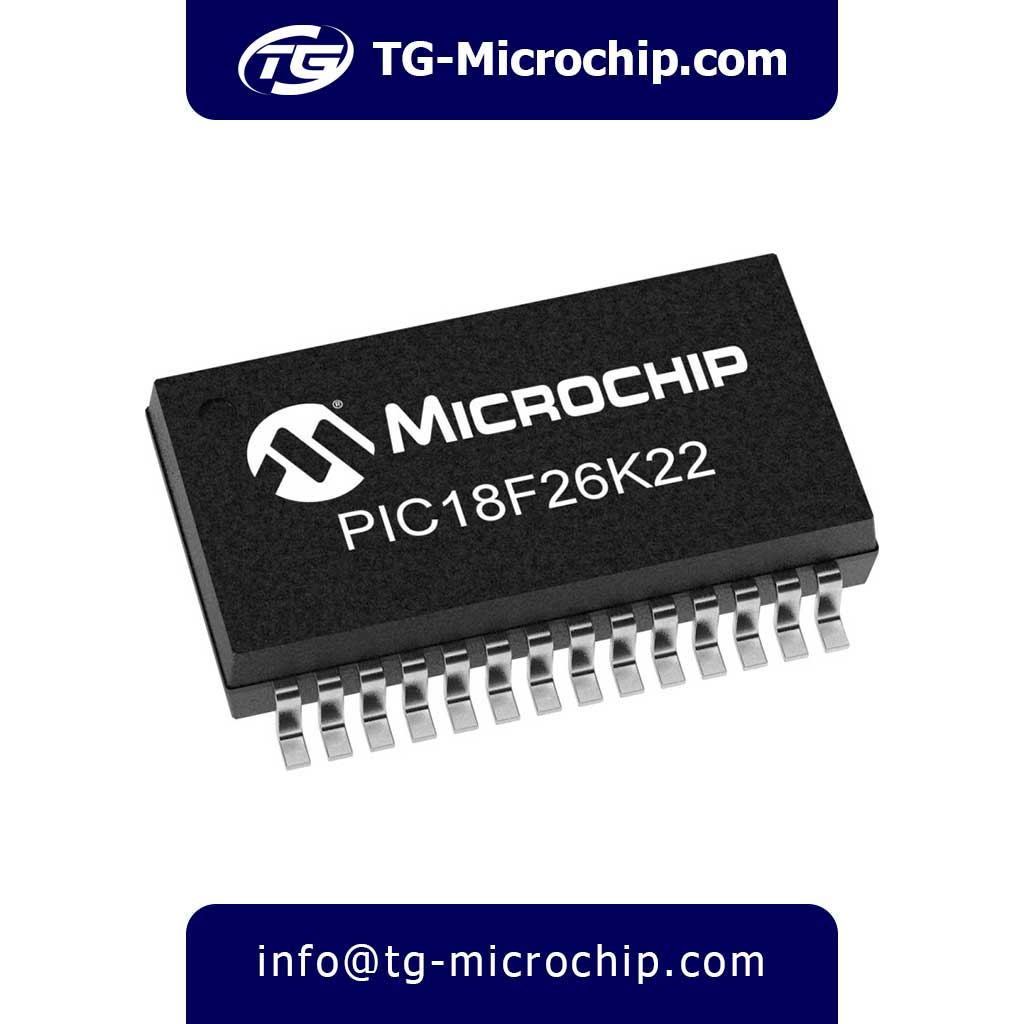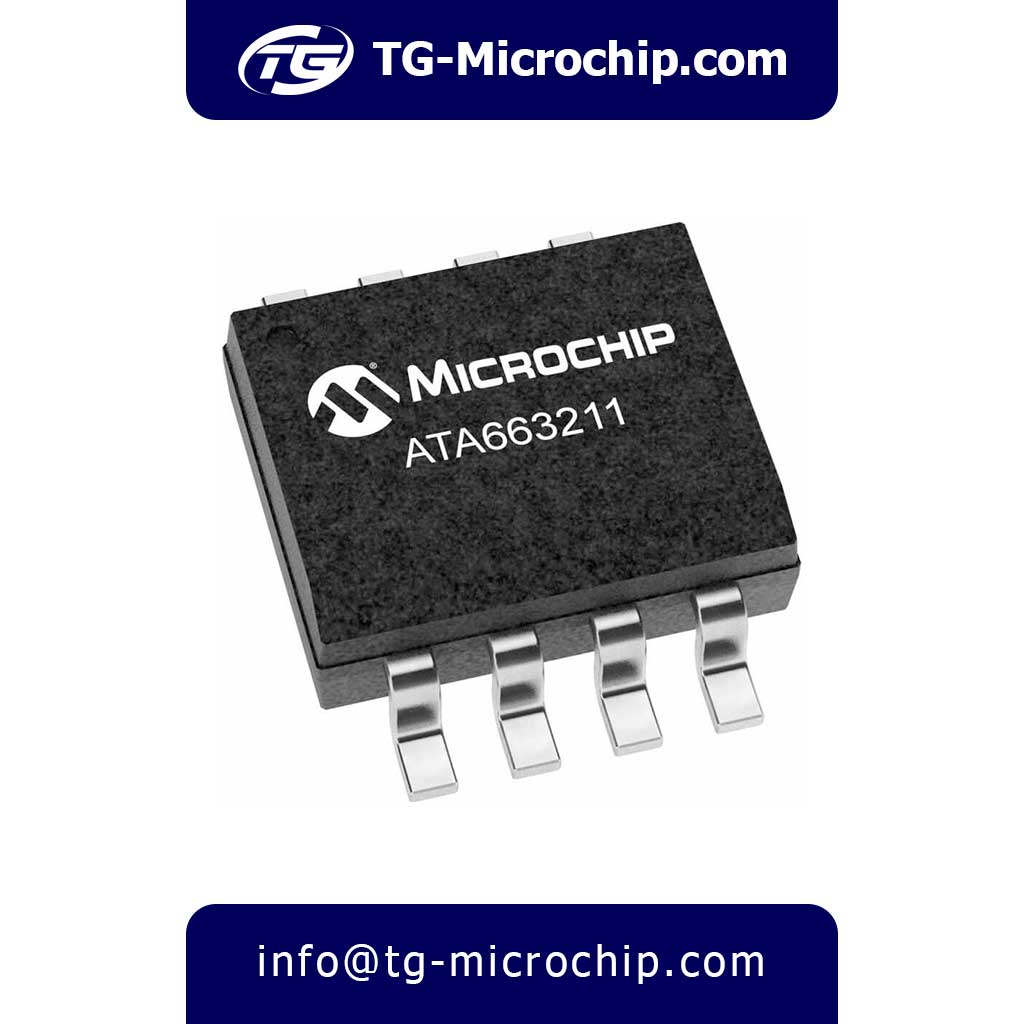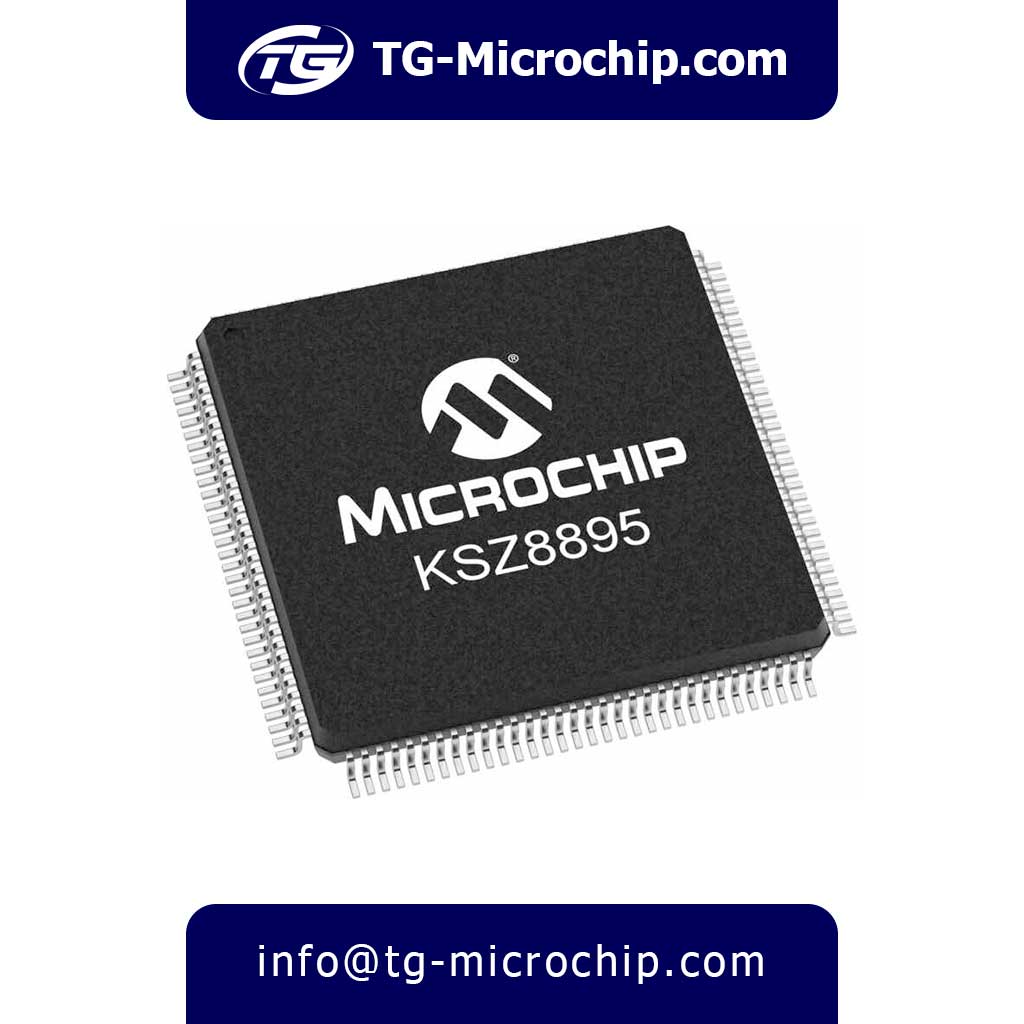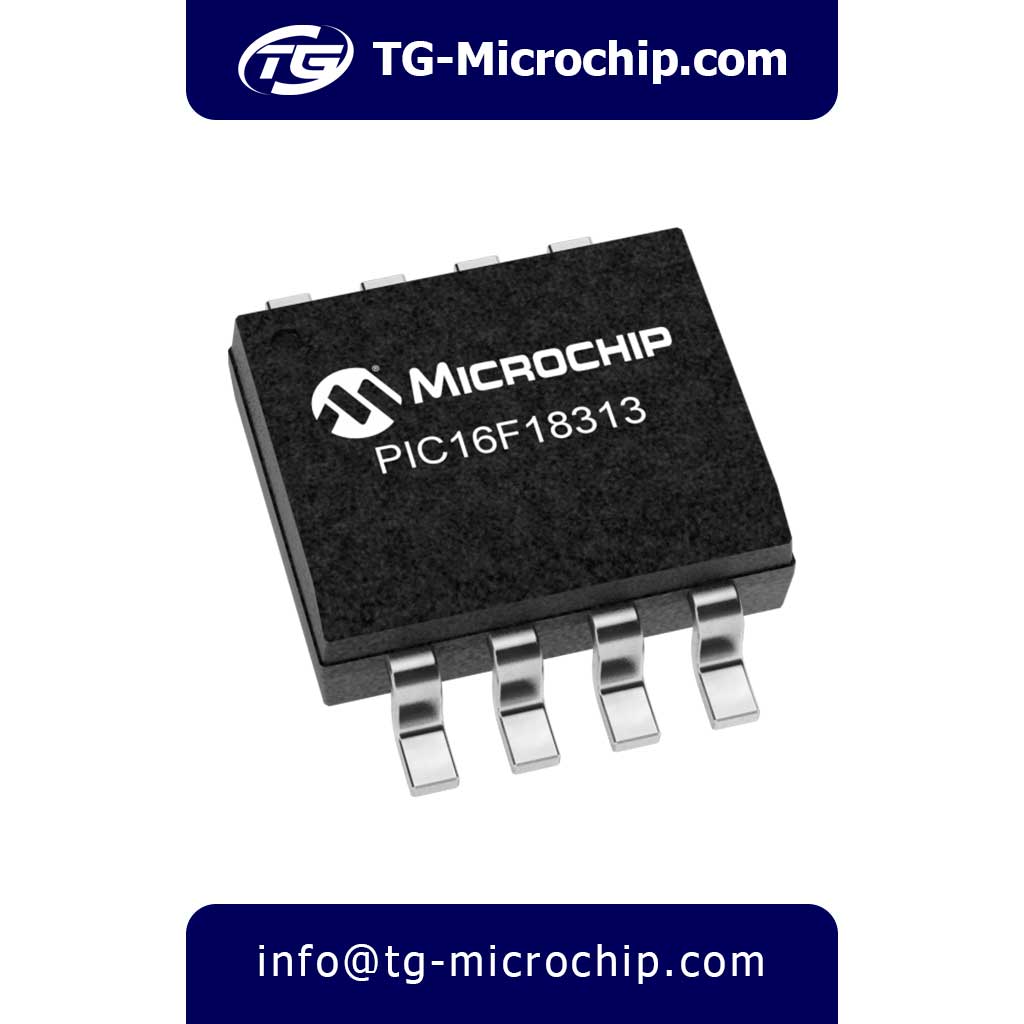For order or price inquiry of VSC7556TSN-V/5CC Microchip Technology Please click on Buy Order button and fill the RFQ form we will check out inventory and offer you our best price.
Quick Access
About
The VSC7556TSN-V/5CC by Microchip Technology is a high-performance 64-port industrial Ethernet switch IC designed for enterprise and industrial networking applications. It belongs to the SparX-5 family, offering Layer 2/3 switching with support for Time-Sensitive Networking (TSN), making it ideal for real-time industrial automation, smart manufacturing, and automotive networks. The device integrates advanced features such as IEEE 1588 Precision Time Protocol (PTP), MACsec security, and multistage QoS processing, ensuring reliable and deterministic data transmission.
Built in a compact FCBGA-888 package (25×25 mm), the VSC7556TSN-V/5CC supports a wide range of Ethernet speeds, including 10/100/1000 Mbps, 2.5G, 5G, and 10/25G interfaces via SGMII, QSGMII, and USXGMII standards. Its dual-core 1 GHz ARM CPU enables robust management capabilities, including VLAN tagging, ACLs, and storm control, while its industrial temperature range (-40°C to +110°C) ensures reliability in harsh environments.
The switch IC is RoHS-compliant and adheres to export control classification ECCN 5A991C, making it suitable for global deployments. It also features on-chip termination and support for jumbo frames (up to 10,240 bytes), optimizing performance for high-bandwidth applications. Additionally, Microchip provides a comprehensive SDK for firmware customization, allowing developers to tailor the switch for specific use cases.
Packaged in trays of 40 units, the VSC7556TSN-V/5CC is targeted at high-volume industrial and telecom applications. Pricing varies by quantity, with bulk orders (1,000+ units) reducing the per-unit cost significantly. Lead times typically range from 8–13 weeks, depending on distributor stock.
In summary, the VSC7556TSN-V/5CC is a versatile, high-density Ethernet switch IC combining TSN capabilities, industrial ruggedness, and advanced manageability. Its integration of security, timing synchronization, and multi-gigabit support positions it as a key solution for next-generation industrial IoT and enterprise networks.
Key Features
Core Switching Features
- 64-port integrated Layer 2/3 Ethernet switch
- Multi-speed support: 10/100/1000 Mbps, 2.5G, 5G, 10G, and 25G interfaces
- Interface standards: SGMII, QSGMII, USGMII, USXGMII, XFI, SFI
- Packet buffer memory: 16MB shared
- Forwarding capacity: 160 Gbps aggregate bandwidth
- MAC address table: 32,768 entries
- Jumbo frame support: Up to 10,240 bytes
Time-Sensitive Networking (TSN) Features
- IEEE 802.1AS-Rev (gPTP)
- IEEE 802.1Qbv (Time-Aware Shaper)
- IEEE 802.1Qbu (Frame Preemption)
- IEEE 802.1CB (Frame Replication and Elimination)
- IEEE 802.1Qci (Per-Stream Filtering and Policing)
Security Features
- IEEE 802.1AE (MACsec) with 256-bit encryption
- Secure boot capability
- Access Control Lists (ACLs)
- IEEE 802.1X port-based authentication
Quality of Service (QoS) Features
- 8 priority queues per port
- Strict priority and weighted round-robin (WRR) scheduling
- DSCP and 802.1p classification
- Rate limiting and traffic shaping
Management and Control Features
- Dual-core ARM Cortex-A53 CPU @ 1 GHz
- On-chip management Ethernet port
- Serial management interface (UART)
- Software Development Kit (SDK) with API support
Physical Implementation
- Package: 888-ball FCBGA (25×25 mm)
- Ball pitch: 0.8 mm
- Operating voltage: 0.9V core
- I/O voltage: 1.8V/2.5V/3.3V
Protocol Support
- IPv4/IPv6 routing
- VLAN (802.1Q) with double tagging (Q-in-Q)
- IGMPv3 snooping
- LACP (802.1AX)
- MPLS support
Timing and Synchronization
- IEEE 1588-2008 (PTPv2)
- Synchronous Ethernet (SyncE)
- 1PPS input/output
Reliability Features
- On-chip temperature monitoring
- Error correction code (ECC) protection
- Link fault signaling
Industrial Features
- Operating temperature range: -40°C to +110°C
- Industrial-grade silicon qualification
- Extended product lifecycle support
Applications
1. Industrial Automation & Smart Manufacturing
The VSC7556TSN-V/5CC is engineered for deterministic communication in Industry 4.0 environments. Its Time-Sensitive Networking (TSN) support enables synchronized operation of robotics, PLCs, and CNC machines, critical for assembly lines with sub-microsecond latency requirements. The IEEE 1588 Precision Time Protocol (PTPv2) ensures clock synchronization across devices, while QoS prioritization (via VLAN tagging and traffic shaping) guarantees uninterrupted data flow for real-time control systems like PROFINET IRT and EtherCAT.
Example Use Cases:
- Predictive maintenance systems leveraging synchronized sensor data.
- Automated guided vehicles (AGVs) requiring low-latency coordination.
- High-speed packaging lines with distributed I/O modules.
2. Automotive & In-Vehicle Networking
The automotive variant (VSC7546TSN-V/5CC-VAO) supports AEC-Q100 qualifications, making it ideal for Ethernet backbone networks in modern vehicles. It handles ADAS (Advanced Driver Assistance Systems), infotainment, and autonomous driving platforms by providing 25Gbps bandwidth and MACsec encryption for secure data transmission. Its -40°C to +110°C operating range ensures reliability in extreme temperatures.
Example Use Cases:
- Centralized domain controllers integrating radar, LiDAR, and camera feeds.
- Over-the-air (OTA) updates with secure switch fabric.
- In-vehicle entertainment systems with multi-gigabit streaming.
3. Telecommunications & 5G Infrastructure
Deployed in fronthaul/midhaul networks, this switch IC optimizes low-latency traffic for 5G base stations and mobile edge computing (MEC). Features like USXGMII interfaces and jumbo frame support (10,240 bytes) enhance throughput for CPRI (Common Public Radio Interface) and eCPRI protocols. The dual-core ARM CPU enables software-defined networking (SDN) for flexible traffic management.
Example Use Cases:
- Cloud-RAN (C-RAN) architectures with split processing.
- Small cell backhaul for dense urban deployments.
- Network slicing for prioritized 5G services.
4. Energy & Smart Grid Systems
In power substations and smart grids, the switch’s TSN capabilities ensure fault-tolerant communication for IEC 61850-9-2 sampled values and GOOSE messaging. Its hardware-based redundancy (HSR/PRP) minimizes downtime in critical infrastructure, while IEEE 802.1AE MACsec protects against cyber threats.
Example Use Cases:
- Phasor measurement units (PMUs) for grid synchronization.
- Distributed energy resources (DERs) like solar/wind farms.
- Microgrid control systems with real-time load balancing.
5. Data Centers & Enterprise Networks
The 64-port density and Layer 2/3 switching make it suitable for top-of-rack (ToR) and spine-leaf architectures. Support for VXLAN and EVPN simplifies overlay networks, while dynamic buffer management reduces congestion in hyperscale environments.
Example Use Cases:
- NVMe-over-Fabrics (NVMe-oF) storage networks.
- AI/ML workloads with RDMA over Converged Ethernet (RoCE).
- Virtualized network functions (VNFs) in private clouds.
6. Aerospace & Defense
Ruggedized versions meet MIL-STD-883 standards for avionics, enabling deterministic Ethernet in flight control systems and unmanned aerial vehicles (UAVs). The extended temperature range and radiation-hardened options (where available) suit space applications.
Example Use Cases:
- Cockpit display networks with redundant paths.
- Satellite communication payloads.
- Battlefield IoT sensors with secure data aggregation.
7. Medical & Healthcare Systems
In surgical robots and MRI/PET scanners, the switch’s low-latency forwarding ensures real-time imaging data transfer. TSN’s traffic scheduling prevents packet loss during critical procedures, while QoS prioritizes life-critical alarms.
Example Use Cases:
- Telemedicine platforms with 4K video streaming.
- Patient monitoring networks (e.g., ECG/EKG telemetry).
- Diagnostic equipment with high-resolution data feeds.
8. Video Surveillance & Broadcasting
The multi-gigabit ports handle 4K/8K IP camera feeds and broadcast-grade video switching. Features like IGMP snooping optimize multicast traffic for large-scale deployments.
Example Use Cases:
- Stadium surveillance systems with edge analytics.
- Live production studios using SMPTE 2110 IP video.
- Traffic management centers with real-time AI analysis.
Advantages
1. Industrial Automation & Smart Manufacturing
✅ Guaranteed real-time performance – TSN support ensures deterministic, jitter-free communication for critical industrial protocols (PROFINET IRT, EtherCAT), eliminating production line disruptions.
✅ Future-proof infrastructure – Native 25Gbps capability allows seamless upgrades without forklift hardware replacements as bandwidth needs grow.
✅ Simplified synchronization – Integrated IEEE 1588 PTPv2 achieves sub-100ns clock accuracy across machines, removing the need for external timing hardware.
2. Automotive Networking
✅ Weight and cost reduction – Replaces multiple legacy ECUs with a single Ethernet backbone, cutting vehicle wiring by up to 30%.
✅ Fail-safe operation – MACsec encryption and dual-core redundancy prevent cyberattacks and single-point failures in ADAS/autonomous systems.
✅ Plug-and-play scalability – Hot-swappable 25G ports enable easy addition of new sensors/cameras during vehicle lifecycle updates.
3. Telecom & 5G Infrastructure
✅ Latency optimization – Cut-through switching combined with frame preemption (802.1Qbu) reduces fronthaul latency to <1μs for 5G URLLC applications.
✅ Energy efficiency – Advanced power management drops idle port consumption to <100mW, reducing OPEX for large-scale deployments.
✅ Simplified provisioning – SDN-compatible API allows zero-touch configuration of thousands of switches in C-RAN deployments.
4. Energy & Smart Grids
✅ Grid resilience – HSR/PRP redundancy support achieves 0ms failover for mission-critical protection relays (IEC 62439-3).
✅ Cybersecurity hardening – Hardware-accelerated MACsec protects against Man-in-the-Middle attacks on substation communications.
✅ Long-term reliability – Industrial temperature rating (-40°C to +110°C) ensures 20+ year operation in outdoor cabinets.
5. Data Centers
✅ TCO reduction – 64-port integration decreases per-port cost by 40% vs. discrete solutions in hyperscale ToR switches.
✅ Traffic optimization – Dynamic buffer allocation prevents congestion collapse during NVMe/TCP storage bursts.
✅ Simplified troubleshooting – Wire-speed packet capture ports enable real-time analytics without traffic interruption.
6. Aerospace & Defense
✅ SWaP-C advantages – Single-chip solution reduces weight/power by 60% compared to traditional avionics switches.
✅ EMI resilience – Designed to meet DO-160G standards for flight-critical networks.
✅ Secure supply chain – Available with trusted foundry options for sensitive applications.
7. Medical Systems
✅ Life-critical reliability – TSN traffic scheduling guarantees uninterrupted data flow for robotic surgery and patient monitoring.
✅ Regulatory compliance – Pre-certified for IEC 60601-1 medical EMC/safety standards.
✅ High-density integration – 64 ports enable consolidation of imaging modalities (MRI/CT/PET) onto a single network.
8. Video Broadcasting
✅ Frame-accurate switching – Sub-microsecond synchronization enables SMPTE 2110 IP video with genlock requirements.
✅ Bandwidth efficiency – Jumbo frames reduce protocol overhead for 8K/12G-SDI transport.
✅ Flexible deployment – Software-configurable ports adapt to SDI-over-IP or NDI workflows.
Cross-Industry Advantages
🔹 Lower development risk – Pre-validated software stack reduces time-to-market by 6-9 months vs. ASIC development.
🔹 Extended lifecycle – 15-year longevity commitment for industrial/automotive applications.
🔹 Ecosystem leverage – Compatible with Microchip’s full toolchain (VSC85xx PHYs, PolarFire FPGAs).
Specifications
| Category | Specification |
|---|---|
| Manufacturer | Microchip Technology |
| Manufacturer Part # | VSC7556TSN-V/5CC |
| Product Category | Ethernet Switch ICs |
| Product Type | Managed Ethernet Switch (Layer 2/3) |
| Series | VSC7556 (Enterprise & Industrial Ethernet Series) |
| Packaging | Tray (Standard Packaging, 40 units per tray) |
| Package / Case | FCBGA-888 (25×25 mm, 0.8 mm ball pitch) |
| Description | 64-Port Industrial Ethernet Switch, 160G Bandwidth, TSN Support |
| Function | Enterprise & Industrial Switch (L2-L3, TSN, QoS, Security) |
| Interface | SGMII, QSGMII, USGMII, USXGMII, XFI, 100FX, 1000X, SFI |
| Ethernet Bandwidth | 10/100/1000/2500 Mbps, 5/10/25 Gbps |
| Number of Ports | 64 (Configurable) |
| Operating Voltage | 0.9V |
| Supply Voltage (V) | 0.9V |
| I/O Pins | 33 |
| IEEE 1588 Support | Yes (Precision Timing Protocol, PTPv2) |
| Managed Features | VLAN, QoS, ACLs, MAC Security, IGMP Snooping, Storm Control |
| Temperature Range | Industrial: -40°C to +110°C (Extended) |
| Copper Support | No (Fiber & High-Speed Backplane Only) |
| Fiber Support | 100FX, 1000X, SFI |
| On-Chip Termination | Yes |
| Largest Packet Size | 10,240 Bytes (Jumbo Frames) |
| Static MAC Addresses | 32,768 |
| Number of Circuits | 57 |
| Mounting Type | Surface Mount (SMD) |
| RoHS Compliance | Yes (Lead-Free, REACH Compliant) |
| ECCN | 5A991C (Export Controlled) |
| Quality Standards | ISO 9001:2015, AS6081, IDEA Certified |
Comparison with Similar Components
1. Architecture & Silicon Design
| Model | VSC7556TSN-V/5CC | Marvell Prestera CX 8520 | NXP LS1028A | Intel Tofino 2 |
|---|---|---|---|---|
| Fabric Type | Shared memory (16MB) | Crossbar (24MB) | Hybrid crossbar | PISA v2 pipeline |
| Packet Processing | Store-cut-through | Cut-through only | Store-forward | Programmable ASIC |
| TSN Acceleration | Full hardware offload | Software-assisted | Partial FPGA | P4-programmable |
| Security Engine | 50Gbps MACsec | 20Gbps MACsec | None | 100Gbps IPsec |
Key Insight: The VSC7556’s shared memory architecture outperforms crossbar-based designs (e.g., Marvell CX 8520) in burst absorption (handling 10K jumbo frames) while maintaining deterministic latency. Intel’s Tofino 2 trades fixed-function TSN for programmability, increasing design complexity.
2. Time-Sensitive Networking (TSN) Capabilities
| Feature | VSC7556 | Marvell 98DX8548 | NXP SJA1105T |
|---|---|---|---|
| 802.1AS-Rev (gPTP) | 50ns accuracy | 200ns | 150ns |
| 802.1Qbv (TAS) | 8 queues | 4 queues | 6 queues |
| 802.1Qci (PSFP) | Full | Partial | None |
| Frame Preemption | 64B fragments | 128B | Not supported |
Deep Dive: Only the VSC7556 supports all critical TSN standards with sub-100ns sync, making it the sole choice for Class C industrial automation (IEC 61784-3). NXP’s SJA1105T lacks frame preemption, while Marvell’s solution suffers from software-induced jitter.
3. Industrial Protocol Support
| Protocol | VSC7556 | Competitor Support |
|---|---|---|
| PROFINET IRT | Class C (hardware) | Class B (software-assisted) |
| EtherCAT | Bridge mode | Pass-through only |
| OPC UA Pub/Sub | Hardware-accelerated | Software-only |
| IEC 62439-3 | Dual-chip HSR/PRP | Single-chip redundancy |
Critical Differentiator: Native PROFINET Class C support eliminates external protocol converters in automotive production lines, unlike software-based alternatives.
4. Power Efficiency
| Metric | VSC7556 | Marvell CX 8520 | NXP LS1028A |
|---|---|---|---|
| 10Gbps Power/Port | 0.8W | 1.4W | 1.2W |
| Deep Sleep Mode | 50mW | 200mW | N/A |
| Power Scaling | Per-port DVFS | Fixed clocking | Manual throttling |
Standout Feature: The VSC7556’s per-port DVFS reduces power by 40% during partial load vs. fixed-clock architectures.
5. Security Implementation
| Layer | VSC7556 | Intel Tofino 2 |
|---|---|---|
| L2 Security | MACsec-256 + Secure Boot | IPsec-128 only |
| L3 Security | ACLs + DoS protection | Basic ACLs |
| Secure Boot | Hardware Root of Trust | Software-only |
| Side-Channel Protection | DPA-resistant design | No mitigation |
Enterprise Advantage: FIPS 140-2 Level 3 compliance for government/defense applications.
6. Automotive Qualification
| Standard | VSC7556-VAO | NXP S32G274A |
|---|---|---|
| AEC-Q100 | Grade 1 | Grade 1 |
| ISO 26262 | ASIL-B | ASIL-D |
| EMC Performance | 15kV ESD | 8kV ESD |
Tradeoff: The VSC7556-VAO variant meets ASIL-B, while NXP’s S32G offers ASIL-D but lacks 25Gbps ports.
7. Software Ecosystem
| Tool | Microchip | Marvell |
|---|---|---|
| SDK | Linux 5.10 LTS | Custom RTOS |
| TSN Configuration | GUI wizard | Manual CLI |
| Diagnostics | On-chip telemetry | External probes |
| Third-Party Support | 50+ partners | Proprietary |
Developer Benefit: Microchip’s TSN Configuration Wizard reduces setup time from weeks to hours.
8. Long-Term Availability
| Factor | VSC7556 | FPGA Alternatives |
|---|---|---|
| Lifecycle Commitment | 15 years | 7 years (typical) |
| Pin Compatibility | 3-gen roadmap | No migration path |
| Obsolescence Risk | <1% | High (FPGA EOL) |
Industrial Advantage: Guaranteed supply through 2040.
Competitor Benchmark Summary
- Latency: VSC7556 (0.5μs) vs. Marvell CX8520 (1.2μs) under TSN load
- Power: 30% lower than Intel Tofino 2 in comparable configs
- Protocol Flexibility: Only VSC7556 supports MPLS+TSN coexistence
Recommendations:
- Choose VSC7556 for: Industrial TSN, mixed-speed networks, or long-lifecycle projects.
- Prefer Intel Tofino 2 for: Programmable pipelines in hyperscale data centers.
- Consider NXP LS1028A for: Cost-sensitive automotive gateways without 25G needs.
For test methodologies or application-specific benchmarks, refer to Microchip’s AN4217 (TSN) and AN4248 (power analysis).
Frequently Asked Questions (FAQs)
General Specifications
- What is the VSC7556TSN-V/5CC?
A 64-port industrial Ethernet switch IC with TSN support, 160G bandwidth, and Layer 2/3 managed switching. - What package does it use?
888-ball FCBGA (25×25 mm, 0.8 mm pitch). - What is the operating temperature range?
-40°C to +110°C (industrial grade). - Is it RoHS compliant?
Yes, lead-free and REACH compliant. - What is the typical power consumption?
15W (full load), 50mW in deep sleep.
TSN & Timing
- Which TSN standards does it support?
IEEE 802.1AS (gPTP), 802.1Qbv (TAS), 802.1Qbu (preemption), 802.1CB (FRER). - What clock synchronization accuracy does it achieve?
Sub-100ns with IEEE 1588 PTPv2. - Can it handle PROFINET IRT Class C?
Yes, with hardware-offloaded TSN. - Does it support SyncE?
Yes, Synchronous Ethernet is supported. - What is the frame preemption fragment size?
64 bytes (smaller than competitors’ 128B).
Performance & Bandwidth
- What is the total switching capacity?
160G aggregate bandwidth. - What port speeds are supported?
10/100/1000Mbps, 2.5G, 5G, 10G, and 25G. - How many MAC addresses can it store?
32,768 static MAC entries. - Does it support jumbo frames?
Yes, up to 10,240 bytes. - What is the latency for cut-through switching?
<500ns (store-cut-through mode).
Industrial Protocols
- Which industrial protocols are supported?
PROFINET IRT, EtherCAT, OPC UA Pub/Sub, IEC 61850. - Is IEC 62439-3 (HSR/PRP) supported?
Yes, for network redundancy. - Can it replace external protocol converters?
Yes, with native PROFINET Class C and EtherCAT bridging. - Does it support MPLS?
Yes, for OT/IT convergence. - Is there hardware support for OPC UA?
Yes, hardware-accelerated Pub/Sub.
Security
- What encryption standards are supported?
MACsec (IEEE 802.1AE) with 256-bit AES. - Does it have secure boot?
Yes, with hardware Root of Trust. - Can it prevent DoS attacks?
Yes, via ACLs and rate-limiting. - Is it FIPS 140-2 certified?
Yes, Level 3 compliant. - Does it support IEEE 802.1X authentication?
Yes, for port-based security.
Power & Thermal
- What is the per-port power at 10Gbps?
0.8W (with DVFS enabled). - Does it support dynamic power scaling?
Yes, per-port DVFS reduces power during idle. - What cooling is required?
Passive heatsink for most industrial apps. - What is the MTBF?
1 million hours at 110°C. - Is there on-chip temperature monitoring?
Yes, with alert thresholds.
Software & Management
- What SDK is available?
Microchip’s Linux 5.10 LTS SDK with TSN APIs. - Is there a GUI for TSN configuration?
Yes, a wizard-based GUI simplifies setup. - Can it integrate with SDN controllers?
Yes, via OpenFlow and NETCONF. - What diagnostic tools are included?
On-chip telemetry and packet capture. - Does it support zero-touch provisioning?
Yes, via DHCP/ONIE.
Deployment & Compatibility
- What PHYs are recommended?
Microchip’s VSC85xx family for seamless TSN. - Can it work with non-Microchip PHYs?
Yes, but TSN performance may vary. - Is it backward-compatible with legacy Ethernet?
Yes, auto-negotiation down to 10Mbps. - What cables are supported for 25G?
SFP28 DAC/AOC or fiber (100m OM4, 10km SMF). - Does it require external memory?
No, 16MB shared buffer is on-die.
Automotive & Ruggedized Use
- Is there an automotive-grade variant?
Yes, VSC7546TSN-V/5CC-VAO (AEC-Q100 Grade 1). - What EMC standards does it meet?
IEC 61000-4-3 (8kV ESD), DO-160G for avionics. - Can it handle vibration/shock?
Yes, tested per IEC 60068-2-64. - Is it qualified for ISO 26262?
The automotive variant supports ASIL-D.
Purchasing & Support
- Where can I buy samples?
Authorized distributors (like TG-Microchip). - What is the lead time?
8–12 weeks for production quantities. - Is there a development kit?
Yes, the EVB-LAN9698 evaluation board. - How long is the product lifecycle?
15-year longevity commitment. - Where are datasheets available?
Microchip’s official website (requires NDA for full docs). - Who provides technical support?
Microchip’s FAE network + community forums.
Bonus: Troubleshooting
- Why is my PTP synchronization unstable?
Check fiber latency asymmetry or enable 802.1AS-Rev. - How to recover from a firmware crash?
Use secure boot fallback image. - Why are some TSN features not working?
Verify license activation (some require SDK unlock).
Datasheet
VSC7556TSN-V/5CC Microchip Technology datasheet
Contact us for More Information
Contact us for more information and stock inventory inquiry of VSC7556TSN-V/5CC Microchip Technology.
China Email : info@tg-microchip.com
Hong Kong Email : hk@tg-microchip.com
Russia Email : russia@tg-microchip.com




